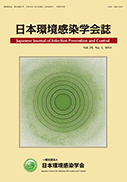Volume 36, Issue 5
Displaying 1-6 of 6 articles from this issue
- |<
- <
- 1
- >
- >|
Review Article
-
2021Volume 36Issue 5 Pages 235-241
Published: September 25, 2021
Released on J-STAGE: March 25, 2022
Download PDF (1775K)
Original Article
-
2021Volume 36Issue 5 Pages 242-252
Published: September 25, 2021
Released on J-STAGE: March 25, 2022
Download PDF (640K)
Report
-
2021Volume 36Issue 5 Pages 253-256
Published: September 25, 2021
Released on J-STAGE: March 25, 2022
Download PDF (264K)
Short Paper
-
2021Volume 36Issue 5 Pages 257-263
Published: September 25, 2021
Released on J-STAGE: March 25, 2022
Download PDF (421K)
Case Report
-
2021Volume 36Issue 5 Pages 264-269
Published: September 25, 2021
Released on J-STAGE: March 25, 2022
Download PDF (594K)
Committee report
-
2021Volume 36Issue 5 Pages 270-283
Published: September 25, 2021
Released on J-STAGE: March 25, 2022
Download PDF (477K)
- |<
- <
- 1
- >
- >|
